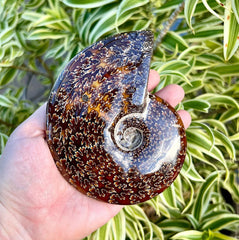
Ammonite Fossils: Extinct But Not Forgotten
Ammonite. You may not recognize the word, but I guarantee you have seen an ammonite fossil. These ocean-dwelling cephalopods went extinct over 66 million years ago, but their fossils can be found all throughout the world. While all fossils connect us to the past, ammonite fossils have the unique ability to connect us and teach us about other living organisms that have gone extinct.
Ammonite Extinction: The End of an Era
Ammonites lived on Earth for roughly 140 million years during the Jurassic and the Cretaceous periods. The Jurassic period is most popularly associated with dinosaurs, and while ammonites and dinosaurs became extinct at the same time, ammonites lived for nearly twice as long as dinosaurs.
At the end of the Cretaceous period, a massive asteroid, estimated to be between 7-9 miles in diameter, hit Earth. This mass extinction is referred to as the Cretaceous–Paleogene event. This event decimated over three-quarters of all species on Earth and all but a handful of four-limbed animal species weighing more than 55 lbs.
These surviving four-limbed tetrapod creatures included mammals, reptiles, birds, and amphibians. The most common tetrapods that survived are part of today’s sea turtle and crocodile families.
The Cretaceous-Paleogene event marked the end of the Mesozoic era and ushered in the beginning of our current era, the Cenozoic era. This event created a thin layer of sediment on marine and terrestrial rocks, and this partition is called the K-Pg boundary. The soil and the clay found in this boundary contains levels of iridium that are surprisingly high. This increased level of iridium metal is typical in asteroids but not Earth's crust.
What did Ammonites Eat?
The primary food source for ammonites was marine plankton. The devastating effects of the asteroid diminished the supply of marine plankton so aggressively that scientists believe the ammonites could not survive.
However, the asteroid itself is not what was so catastrophic for plant life; it was the lingering winter as a result of the asteroid. This persistent winter frost ceased photosynthesis in plants and plankton. This theory is known as the Alvarez hypothesis.
Plankton are single-cell organisms that are carried along by the tides and currents of the ocean and are therefore known as marine drifters. The name plankton comes from the Greek word meaning "drifter" and "wanderer." They have always played an integral role in the aquatic food web.
There are 2 main types of marine plankton:
- Phytoplankton
- Zooplankton

Phytoplankton are plants that get their energy through photosynthesis. They are very buoyant and tend to float near the surface of the ocean to absorb natural sunlight. They account for over half of the photosynthesis on planet Earth and are by far the most important producer of oxygen. Phytoplankton require nitrate, calcium, and phosphate to survive and thrive.
There are two main classes of phytoplankton:
Dinoflagellates: possess whip-like tails called flagella to navigate through the water. Their bodies are covered in shells.
Diatoms: they also have shells but have a rigid body structure composed of interlocking parts. They rely solely on the water current to assist them in traveling through the ocean.
Zooplankton are tiny animals that live near the surface. Zooplankton, along with other tiny aquatic organisms, eats phytoplankton. They then become food themselves for fish and other larger marine species. Thus, their role is to work as an intermediary to transfer energy from phytoplankton to larger organisms.
Zooplankton are broken down into 2 categories:- Primary consumers: feed on free-floating phytoplankton, like algae.
- Secondary consumers: feed on other zooplankton.
The Alvarez hypothesis received further support with the discovery of the Chicxulub crater in the Gulf of Mexico. This 112-mile crater discovery in the early 1990s provided definitive evidence that the K-Pg boundary contains debris from an asteroid impact.
How to Date a Fossil
Today, ammonite fossils are used as indexing fossils. Indexing fossils are used to date other types of fossils that are found in the same marine rock layers. Scientists use what they know about the ammonite fossils traits to determine the age-related information for fossils found in the same place.
Ammonites lived during the Mesozoic era, and as they evolved, their shell structures began to change. This shift in the structure and design of their outer shell is a significant indicator in dating fossils. As they progressed, their shells became smaller, more complex, and more tightly coiled.
Ammonite shell designs began as simple lines etched across their shells. Then, near the end of the Cretaceous period, their shells developed intricate designs. Scientists believe the detailed patterns allowed the ammonites to have greater buoyancy control.
The prevalence of ammonite fossils, in addition to their developing shell designs, aid in the identification of fossils. Copious amounts of ammonite fossils are found all throughout the world. The abundance of ammonite fossils gives scientists a measurement that is widespread and consistent. In addition, a multitude of ammonite species that lived during distinct time periods can be used to index fossils using the suture patterns on their shells.
In addition to helping scientists and researchers index fossils, the ammonite fossils reveal climate information and the location of ancient seas. Researchers believe that they lived in shallow water, less than a quarter mile from the surface. Identifying locations that once belonged to bodies of water is a helpful indicator in the study of climate change.
Shape of the Ammonite Fossil
The ammonite gets its name from the Greek god named Ammon, who had ram horns on the sides of his head. At least 10,000 species of ammonites existed. Along with varying shell designs, ammonites have different shapes.
The most common ammonite fossils are shaped like a ram’s horn, hence the name. However, ammonite fossils are also found in snail-like, tubular, and elongated shapes. Their shells range from smooth to bumpy and ribbed, and the shell ridges are believed to be a defense against predators.
Ammonites are extinct marine mollusk predators that are part of the cephalopod family. Cephalopods are brilliant ocean creatures that once depended on their shells for protection but evolved into animals that have mainly shed their shells and now rely on their high intelligence and flexible appendages to survive and ward off predators.
What Cephalopods are Alive Today?

- Octopus
- Squid
- Cuttlefish
- Shell-chambered nautilus
The soft body of the ammonites did not survive the fossilization process. However, researchers know that the soft body reflects that of the octopus and squid. In addition, we know from the abundance of ammonite fossils that modern-day shell-chambered nautiluses closely resemble the extinct ammonite.
Ammonites moved themselves through the ocean by adjusting their buoyancy and using a jet-propulsion technique. They were believed to have swum backward by squirting water out one end of their shells in order to propel them in the opposite direction.
The outermost chamber of the ammonite contained its body, including a siphuncle. A siphuncle is a tube made of calcium carbonate that is found in shelled cephalopods. This tube contains living tissue and actively pumps fluids or gas out of empty shell chambers to maintain buoyancy, allowing ammonites to float.
Size Matters for Ammonite Fossils
Ammonite fossils come in a wide variety of sizes. Some are only a few millimeters, while others are over two feet wide. While there are over 10,000 species of ammonites, the larger species began to make an appearance near the tail end of the Jurassic era as part of their evolution. The largest recorded ammonite fossil species is the Parapuzosia seppenradensis from the end of the Cretaceous era.
The biggest ammonite fossil ever found was discovered in Westphalia, Germany, in 1895 by a local historian and zoologist named Theodore Nopco. It is part of the Parapuzosia seppenradensis species and measures 5.9 feet across. Although the living chamber of the fossil is incomplete, scientists agree that if completed, it could measure over 11 feet in diameter!
The total mass of the most oversized ammonite fossil shell comes in at a whopping 1,550 lbs. However, it is estimated that the total livable mass, if completed with the soft body, would surpass 3,210 lbs.
This gigantic fossil is on display at the LWL-Museum für Naturkunde; this translates to the LWL Museum of Natural History and Planetarium in Münster, Germany. It has also become the symbol of the museum and is used in their marketing material.
You can find casted replications of this incredible ammonite fossil throughout the world. You can also purchase your own ammonite fossils to wear or display as decor in your home or office.
- Small and large ammonite fossil pendants
- Split pair of ammonite fossils
- Half of an ammonite fossil
History of Ammonites
Ammonite fossils have had a vast and essential impact on the scientific community, especially in regard to discovering the origins of other fossils. However, ammonite fossils have also played an integral role in different human cultures throughout history.
Medieval Europeans referred to ammonite fossils as "snake stones'' as they resembled coiled up snakes. They used them to cure snakebites and also believed they could be used as a cure for common poisons they encountered.
It is believed that St. Hilda, the 7th-century Saxon abbess of Whitby, rid the region of snakes by turning them into stones that we now know are ammonite fossils. Some Europeans would carve heads into the fossils to resemble a snake and then sell them for profit.
North American tribes such as the Crow, Sioux, and other Great Plains tribes used the ammonite fossils as healing stones, similar to how we use healing crystals today. They believed they had the power and ability to heal injuries and bring good fortune.
The ammonite fossils were most commonly used to bring luck in the following areas:- Marriage
- Hunting
- Travel
- War
In the modern-day, ammonite fossils are still used in healing chakras. Ammonite fossils are associated with the first chakra known as the root chakra. The root chakra is located at the base of your spine and is associated with security and stability.
The spiralized shape of ammonite fossils is said to be ideal for unblocking a clogged root chakra. In addition, Opalized ammonite fossils are associated with cleansing and purifying the aura. This spiralized shape creates an overall increase in energy and clarity throughout the body.
Ammonite fossils have a substantial role in Feng Shui. Much like in aligning chakras, the spiralized shape keeps the energy flowing throughout your physical space continually, leaving no opportunity for negative energy to linger in your home or office. Think of it as an air purifier for your mind, body, and soul!
Making Ammonite Models
A great activity for learning about ammonite fossils and their intricacies is making models of them yourself. You only need a few ingredients and access to an oven to make salt-dough fossils in your kitchen.
Creating a variety of different fossil designs and ridge patterns is a great hands-on way to learn about the evolution of ammonites. We have a wide selection of ammonite fossils for you to choose from and base your designs on.
How To Make Your Own Salt-Dough Fossils
Ingredients:
- 1 cup salt
- 2 cups flour
- ¾ cup water
- String
- Baking Tray
Directions:
- Research which ammonite fossils you want to recreate.
- Preheat the oven to 250 degrees.
- Mix salt and flour in a bowl, gradually add water to the mixture.
- Roll salt dough into a long sausage shape.
- Use the string to wrap around the salt-dough shape to create lines and ridges. The harder you squeeze the rope, the deeper the indention.
- Roll your salt dough into a snail or ram’s horn shape.
- Salt-dough ammonite fossils can take 45 min to 3 hours to fully bake, depending on their thickness.
Once your salt-dough fossils have been removed from the oven and cooled completely, you can bury them in your backyard to create your own archeological dig.
Ammonite For All
Ammonite fossils possess the incredible power of connecting modern-day scientists with our past. Most fossils will tell you about the creature they belong to in addition to some insight into their environment. What sets the ammonite fossils apart is how they provide information on not only their specific environment but the climate and time period of many other fossilized species.
Ammonite fossils have played a significant role in the history of humans' belief in the healing powers of healing stones and crystals, which continues to this day. The abundant supply of ammonite fossils allows an unlimited number of people to connect with our past and gain healing capabilities through fossils.






